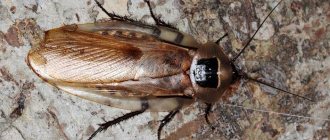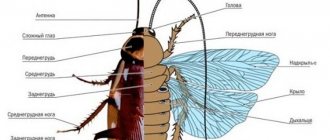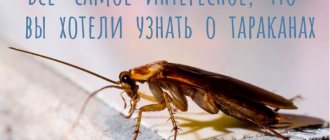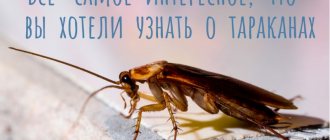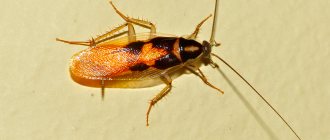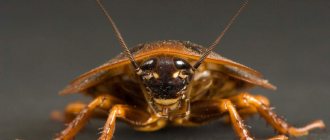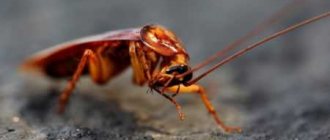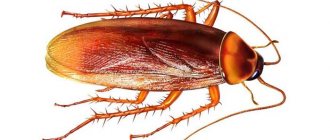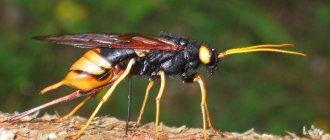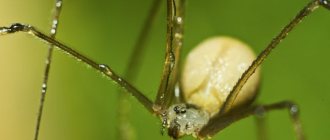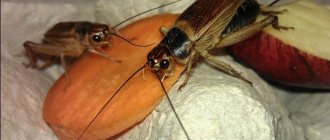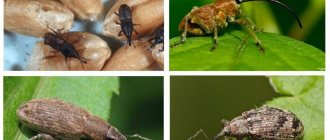Color spectrum
There are 2 types of cockroaches found everywhere – black and red. The first prefer damp, dark rooms; they live in sewer hatches, basements, and cellars. The latter often inhabit apartments in multi-storey buildings and even reach the upper floors. They occupy several rooms - a bathroom, a toilet, a kitchen, a corridor, a pantry.
The black cockroach has a dark color, close to black. The body is shiny, as if covered with fat. Impressive sizes up to 4 cm make insects especially noticeable.
Red Prussians are brown in different tones. The larvae are always lighter. The head is black, the last segments of the flat body are also dark in color.
The external structure of a cockroach may differ in size and color, but the internal systems of all members of the genus are the same.
External structure of cockroaches
The order “cockroaches” is quite numerous and numbers up to 7 and a half thousand species. In our territories, the most numerous is the red cockroach or Prusak, as it is also called. Black cockroaches are less numerous, with the American cockroach being a fairly rare species. The structure of cockroaches, despite their species, is almost identical, although they differ in size and color.
Interesting to know! The structure of modern cockroaches is practically no different from the structure of their ancient representatives of the order “cockroaches”, in the form of Ignaroblatta, which was found in fossils. Their size was 4 times larger than the Prussians, but at the same time they were smaller in size compared to modern giant cockroaches. Moreover, they were the most numerous representatives of this genus who lived within the ancient continent of Gondwana.
The structure of their body is considered quite perfect, so it is not surprising that these insects have retained all their basic qualities for many millions of years.
The cockroach has a flattened body, which allows it to penetrate through the narrowest cracks, while the body consists of 3 parts: head, chest and abdomen.
Head
It has a triangular shape and is inclined downwards. The top is covered with a shield that extends from the dorso-thoracic region. Only the occipital part is clearly visible.
The structure of the eyes and head of a cockroach
Organs of vision
On the sides there are small round organs of vision. A cockroach's eye sees surrounding objects in the form of a mosaic; there is no complete picture. But the insect perceives flickering light better than a human. The perception of what is happening is such that a person moves as if in thick syrup. The insect manages to take off even before the slipper starts after it.
Interesting!
In front of the head there is an additional pair of eyes; according to experts, these organs help insects see well in the dark.
Sense organs
Long whiskers play a special role in the life of insects. It is at the same time an organ of smell, touch, communication, and thermal sensitivity. The movable whiskers contain nerve endings that send signals to the brain. Adults have about 80 such processes. With the help of long whiskers, insects receive and send information and keenly sense odors, even the weakest ones.
Interesting!
Fights constantly take place between males for the right to own females, during which rivals try to gnaw off each other's mustaches. An insect deprived of one antenna becomes an outcast, like a cripple. If two whiskers are lost at once, the cockroach dies from helplessness.
Oral apparatus
It is a complex system:
- The movable upper lip is connected to the head. Evaluates the quality of food and determines taste. The lower one includes several parts. The keratinized particles of the chitinous covering help to gnaw food and prevent it from falling. Taste buds help analyze the quality and composition of products.
- The massive lower jaw with many sharp teeth holds food in the mouth. The upper movable jaw grinds it, crushes it.
- In the cavity of the oropharynx there is a salivary gland, a formation similar to the tongue. With its help, the insect drinks liquid.
On a note!
Massive jaws and a large number of teeth allow cockroaches to gnaw hard food - wood, cardboard, leather goods.
Features of the structure of the Prussian
The thoracic region and the purpose of the paws
On the thoracic part of the cockroach's body there are wings with elytra, as well as insect legs. Cockroaches, like any representative of the “insect” class, have 6 legs, that is, 3 pairs. Each tarsus is located on one of the thoracic segments and represents:
- Prothoracic legs, which have the shortest length and serve as “brakes” if the insect moves too quickly.
- Medium-thoracic paws that can move in any direction, providing the insect with high maneuverability.
- The metathoracic legs are designed to move the insect only forward. They are the longest in size.
The cockroach's paw is a rather complex mechanism, which includes 5 segments. The thighs, flattened in shape, are armed with spines below. The first 4 segments are armed with pads, and the fifth with claws with a suction cup located in the center. This allows the insect to crawl on both horizontal and vertical surfaces.
Interesting fact! Having relatively long legs helps the cockroach not only run fast, but also jump high. In addition, with the help of all 3 pairs of limbs, the cockroach takes care of itself from the head to the abdomen.
In other words, the insect uses 3 pairs of its legs for its intended purpose. Cockroaches are able to move along the surface at a speed of about 4 kilometers per hour. If a cockroach grew to the size of a cheetah, it could easily outrun it. With the help of sensitive hairs located on the legs, the cockroach assesses the situation around itself. In 1 minute he is able to change his trajectory up to 30 times.
Here, on the thoracic region, the wings with more rigid elytra are attached. Using the length of the wings, you can determine the gender of individuals: females have much shorter wings. These insects use their wings during the mating season, as well as when moving or falling. By spreading their wings, individuals demonstrate their readiness to mate. Despite the presence of wings, cockroaches cannot fly, although there is one species that lives in South and Central America that can fly.
Abdomen
It consists of 11 segments, on the last one, males have cervical processes that do not represent any benefit to the insect. In females, the ootheca is located in this place. Up to 16 larvae develop in it after each fertilization. At the anal end of the abdomen, near the cerci, the hearing organs are located.
Interesting!
The weight of an adult cockroach is less than 8 mg. The body size increases gradually as the nymph grows, and does not exceed 15 mm in length.
Appearance of a cockroach Nymphs only after 5 molts grow wings, form genitals, and lengthen their whiskers. The internal structure of a cockroach is just as surprising as its external structure.
Reproduction
The life cycle is divided into three forms of development: egg, nymph, adult. In the summer, cockroaches begin to mate. Females lay eggs in a chitinous cocoon, which holds 16 eggs. A female expecting offspring has a slightly enlarged belly. After a few days, she hides the eggs in a place hidden from view. The incubation period lasts 44 days, and then the larvae - small cockroaches - are born. Black insects live from several months to 4-5 years.
Systems from the inside
Experts say that insects are driven by the instincts of thirst, hunger, safety, and sex. It becomes interesting whether the cockroach has a brain. Another interesting observation suggests that a Prussian can live for a week without a head.
Nervous system
The functions of the brain are performed by 2 large nerve plexuses located in the head. They are responsible for the functional activity of the eyes, lips, and antennae. The central nervous system consists of 11 nodes, which are responsible for the movement of the wings, paws, head, thoracic region, and sensitivity of the reproductive system.
Interesting!
The division of functions between the brain center and the central nervous system makes it possible to live without a head for almost a month in cool conditions. The brain does not regulate breathing and is not responsible for digestion. There is no pressure in the circulatory system, so the cockroach does not bleed. Energy is not wasted, which allows you to do without food.
The nervous system of the cockroach ensures the activity of all senses and coordinates movement.
Circulatory system
A cockroach's blood is white, functions freely inside, and washes its organs. There is no pressure in the system, so the Prussian does not suffer from bleeding in the event of a serious injury.
The cockroach's heart is formed by a tubular organ that helps circulate blood inside. But the process occurs slowly, which is why cockroaches are unusually sensitive to low and high temperatures. At zero, all life processes slow down; at temperatures above 35 degrees Celsius, the insect dies from dehydration.
Respiratory system
On the sides of the abdomen there are 10 segments of spiracles, which provide oxygen to all internal organs and systems. An interesting feature of holding their breath for 40 minutes makes cockroaches the laziest creatures on the planet. Insects do not breathe for most of their lives.
Habitat
Cockroaches prefer to live near humans. They live in warm and humid places, as they are unable to do without water and heat. At temperatures below 0 °C, cockroaches die. Insects in hot countries breed outside the boundaries of living quarters. In our latitudes, they prefer a combined bathroom, kitchen and bathroom.
Cockroaches feel great behind heating radiators, in hidden corners, household appliance cabinets, under sinks, and behind refrigerators. Our ancestors were much more familiar with these insects. Various legends are associated with them. One of these beliefs says that cockroaches bring prosperity to the house. When moving, people took black cockroaches with them “for good luck.”
Interesting Facts
- In ancient times, cockroaches were one of the main ingredients of folk medicine: fried cockroaches with garlic were used for indigestion, and tea made from dried cockroaches was given to patients with dropsy.
- In the countries of South America and Southeast Asia (China, Korea, Thailand, Vietnam, Cambodia, Madagascar), cockroaches are eaten, and this insect is one of the important components of national cuisine. For example, Madagascar hissing cockroaches are edible.
- In ancient Rus', it was believed that cockroaches attracted wealth into the house, therefore, when moving to a new home, they took a couple of cockroaches with them “for good luck.”
- A cockroach with a severed head dies only a few days later, and not from loss of head, but from dehydration.
- Cockroaches and scorpions are the only ones on the planet who are not afraid of nuclear war. Due to a very slow cell division cycle, these animals have increased resistance to radiation.
Due to the fact that black cockroaches have been known to mankind for more than 3 centuries, various beliefs and unusual facts associated with these insects have appeared at different times. For example, in the old days, cockroaches often hid behind a warm stove, which is why they began to be called “baked dwellers.”
There was also a legend that the appearance of black barbels in the house promised wealth to the owners, so they even fed them and took them with them when moving to a new home. Ancient healers prepared a healing potion from cockroaches, used for digestive disorders. It consisted of garlic and insects fried in oil.
In Asian countries such as Thailand, South Korea, Cambodia and Vietnam, cockroaches are still considered an essential component of many national dishes. They are eaten fried, stewed and dried, and are also offered to all tourists to try. Such food preferences are explained by the high content of high-quality protein in the body of insects.
Scientists entomologists, in the process of many years of studying various insects, discovered an interesting fact that cockroaches are not affected by radiation due to their slow biological processes.
According to archaeological excavations, cockroaches appeared during the period of dinosaurs and reached sizes of 50 cm in length or more. Modern data confirms another fact - cockroaches are able to sense the approach of heavy rain, which is why they diligently rush to take cover even at night.
The life of cockroaches is inextricably linked with human life, which is why there are frequent cases of dreams involving these insects. To understand why black cockroaches are dreamed of, you should turn to specialized interpretative books.
A dream involving gigantic cockroaches can be a warning about possible intrigues on the part of influential relatives or friends. But if a white cockroach appears in a dream, you should expect trouble.
Popular message topics
- Art of Ancient Egypt
Egypt has a rich history and culture. First of all, Egypt is associated with pharaohs and ancient pyramids, which amaze with their grandeur. The reign of the pharaohs greatly influenced the development of art in Ancient Egypt. - Dubov's work
Nikolai Dubov is a Soviet and Russian writer. His prose is truthful and sincere, its authenticity arouses interest among adult and young readers. Let's take a closer look at his work. - Yakutia
Yakutia or the Republic of Sakha is the largest region in Russia and is located in the Far Eastern Federal District. Its area is adjacent to Krasnoyarsk, Khabarovsk, Irkutsk, Chita, Amur,
